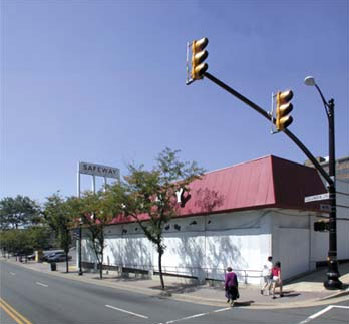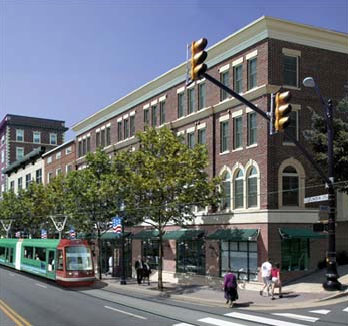

(Photo sequence illustrating the transformation of a blighted suburban-style strip into a thriving urban neighborhood complete with streetcar from Urban Advantage.)
There is a crisis involving land use in the State of California, a slow-motion train wreck that has been playing out over many decades and has resulted in an unhealthy, unsustainable landscape of foreclosed homes and a disposable built environment that works better for automobiles than it does for actual people. For nearly as many decades, environmental groups groups have been trying to solve this problem by working to achieve smarter regional planning frameworks that can simultaneously promote walkable, local communities while protecting open space.
The Vision California project seeks to articulate the solutions to this land use and transportation crisis in a manner that delivers extremely rapid results, timed to coincide with the important policy decisions being made during this time of rapidly-changing state air quality and land use policies.
I'm lucky enough to be able to work on the Vision California project in my capacity as a Senior Planner with Calthorpe Associates, which is the lead consultant in charge of the project.
For more information on Vision California, please find it under the "Sustainability and High-Speed Trains" portion of the California High Speed Rail Authority's online library, at:
http://www.cahighspeedrail.ca.gov/library/
If anybody expresses interest in the comments, I'd be happy to share more information on the project.
cheers,
~Garlynn





3 comments:
are the rapid results in the planning and projections? it would be nice if the implementation would be a little more rapid — so much bureaucracy around putting transit in, when it seems like they can go ahead and widen a highway with relative ease.
definitely interested in hearing what's going on...
The rapid results are, indeed, in the planning and projections. Unfortunately, as visionary as our firm may be, we have very little ability to influence how long it takes for a brick-and-mortar project to actually find funding, go through environmental and community review, let contracts and proceed through the construction process, then complete testing and open for service.
I'll post more on this topic in the near future.
cheers,
~Garlynn
Garlynn
In looking at the illustration photo I was wondering if there are any setback requirements. I notice the streets I like the best are those where there is a larger set back from the street to encourage pedestrians to walk or sit. The ones that are really nice, even if they're old and worn, are the ones with a bit of green to buffer and soften the area. I'd be interested in your thoughts on this.
Thanks,
Mark
Post a Comment